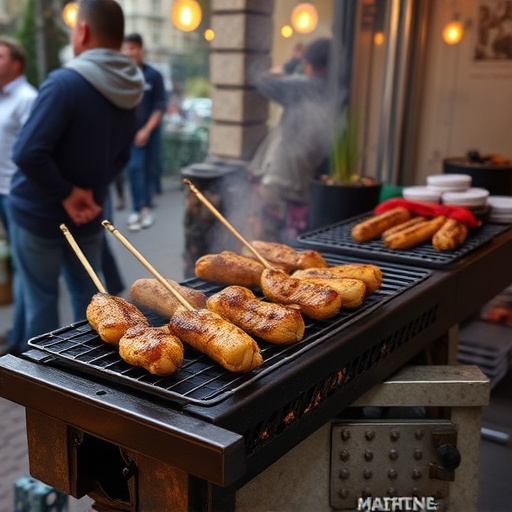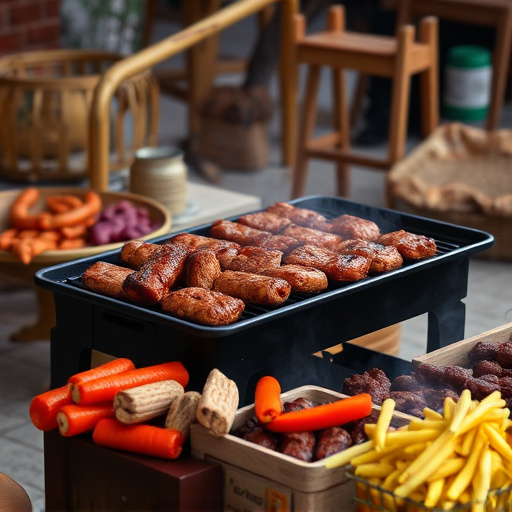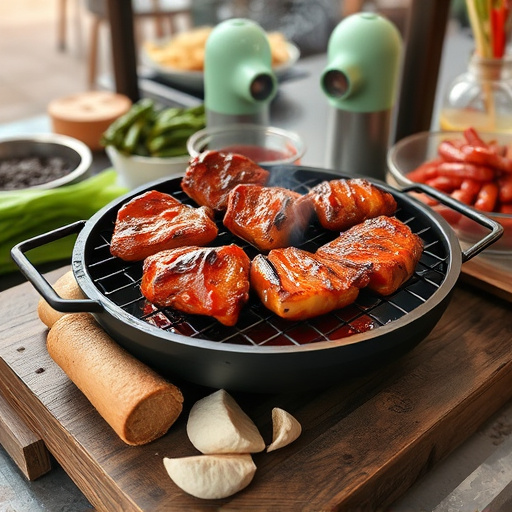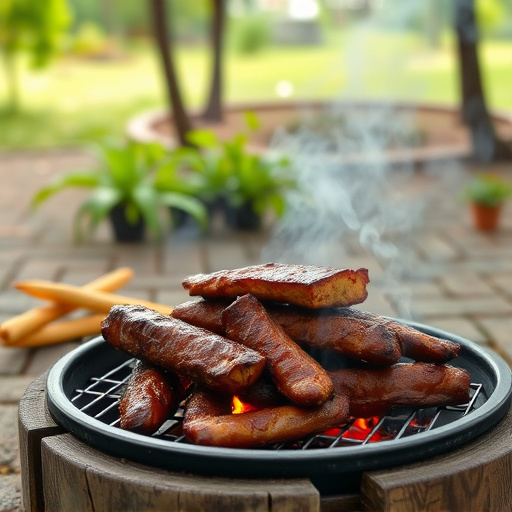Crafting a delicious BBQ pork tenderloin starts with high-quality, uniformly thick (1 inch or less) meat seasoned with salt and pepper. Marinating or dry brining enhances flavor. Grilling involves understanding direct and indirect heat to achieve medium-rare doneness at 145°F (63°C). Resting the cooked meat for 10-15 minutes before slicing ensures juicy, flavorful slices.
“Unleash your inner grill master with this comprehensive guide to crafting the perfect BBQ pork tenderloin. From selecting the finest cut to achieving that mouthwatering crust, we’ll walk you through each step. Learn to create a flavorful marinade, explore the art of dry brining for enhanced taste, and master grilling techniques using direct or indirect heat. By following these simple yet effective tips, you’ll consistently cook juicy, tender pork tenderloins that will impress any crowd.”
- Selecting and Preparing Your Pork Tenderloin
- Creating the Marinade for Flavor Explosion
- The Art of Dry Brining (Optional but Recommended)
- Mastering the Grill: Direct vs Indirect Heat
- Timing and Temperature for Perfection
- Slathering on Sauces and Resting for Maximum Juice
Selecting and Preparing Your Pork Tenderloin

When it comes to crafting a mouthwatering BBQ pork tenderloin recipe, the first step is to select the perfect cut of meat. The pork tenderloin is a lean, versatile muscle located between the loin and ribs, known for its delicate flavor and tender texture when prepared correctly. Look for a piece with uniform thickness, aiming for about 1 inch (2.5 cm) or less, to ensure even cooking. Avoid any that have visible fat streaks, as this can make the meat tough.
Before cooking, prepare your pork tenderloin by patting it dry with paper towels. This step is crucial for achieving a crispy, golden crust. You can also season it generously with salt and pepper on both sides to enhance its natural flavor. Some chefs like to marinate the tenderloin in a mixture of herbs, spices, and oils for added depth, but this is optional depending on your preferred BBQ pork tenderloin recipe.
Creating the Marinade for Flavor Explosion

To elevate your BBQ pork tenderloin recipe, creating a flavorful marinade is essential. Start by combining olive oil, garlic, fresh herbs like rosemary and thyme, and a blend of spices such as salt, pepper, paprika, and cayenne pepper in a bowl. Whisk these ingredients together until well-mixed, ensuring the garlic and herbs infuse the oil with their aromatic essence. Add a squeeze of lemon juice for acidity, which brightens up the flavors and tenderizes the meat slightly.
Let the marinade sit for at least 30 minutes to allow the flavors to penetrate the pork tenderloin. The longer it marinates, the more intense the flavor explosion will be. You can even prepare the marinade ahead of time, storing it in the refrigerator for up to 24 hours before using it to coat your tenderloin. This allows for deeper penetration of flavors, making your BBQ pork tenderloin recipe truly exceptional.
The Art of Dry Brining (Optional but Recommended)

The art of dry brining is an optional step that can significantly enhance the flavor of your BBQ pork tenderloin recipe. It involves curing the meat with a mixture of salt, spices, and herbs, drawing out moisture and infusing the pork with deep, savory taste. This method is particularly recommended for tenderloins as it helps to break down connective tissues, making the meat incredibly tender and juicy when cooked.
By dry brining your tenderloin, you get to control exactly what flavors coat your meat. A simple blend of salt, pepper, garlic powder, and paprika can be all you need, but feel free to experiment with additional spices like mustard seed or even a touch of brown sugar for a sweeter profile. Allow the meat to sit in the refrigerator for 12 to 48 hours, turning it occasionally, before proceeding with your BBQ pork tenderloin recipe. This lengthy process ensures that every bite is bursting with flavor.
Mastering the Grill: Direct vs Indirect Heat

Mastering the art of grilling pork tenderloin is crucial for achieving a delicious BBQ treat. The key lies in understanding the difference between direct and indirect heat, which can transform your dish from good to exceptional. When cooking a bbq pork tenderloin recipe, direct heat involves searing the meat over high temperatures, creating a crispy exterior and sealing in juices. This method is perfect for initial stages of cooking, as it quickly raises the internal temperature.
On the other hand, indirect heat allows for slower, more even cooking, ensuring the pork tenderloin reaches its ideal internal temperature without overcooking the exterior. This technique is especially valuable when aiming for a medium-rare or milder doneness. Indirect heat can be achieved by using a grill’s side burners or creating a zone with hot and cooler sections, allowing you to gently cook the meat until it’s tender and juicy, ready for that mouthwatering BBQ experience.
Timing and Temperature for Perfection

When it comes to achieving that perfect, juicy, and tender BBQ pork tenderloin, timing and temperature play a crucial role. The ideal internal temperature for this cut of meat is 145°F (63°C). This ensures that the pork remains moist and tender while eliminating any food safety concerns related to undercooked meat. For a BBQ pork tenderloin recipe, a good rule of thumb is to grill it for about 25-30 minutes per pound at a moderate to high heat—around 375-450°F (190-230°C). This allows the exterior to crisp up while locking in that delicious juices inside. Remember, proper temperature control is key; using a meat thermometer will ensure you hit that sweet spot every time.
Slathering on Sauces and Resting for Maximum Juice

After seasoning your pork tenderloin and cooking it to perfection, the next step is to enhance its flavor and ensure maximum juiciness. Slathering on a sauce isn’t just about adding taste; it also helps to keep the meat moist during rest time. This is crucial for a BBQ pork tenderloin recipe as it prevents the lean cut from drying out.
Opt for a sauce that complements your preferred cooking method—whether it’s a simple rub, marination, or a slow-cooked BBQ sauce. Apply the sauce generously after the initial sear or during the last few minutes of cooking. Letting the meat rest after removing it from the heat is an often-overlooked step in achieving tender, juicy results. During rest, the juices redistribute throughout the tenderloin, ensuring every bite is saturated with flavor and moisture. Aim for a resting period of 10-15 minutes before slicing to allow these magical processes to occur.
